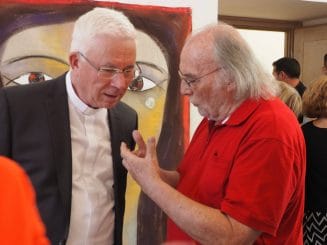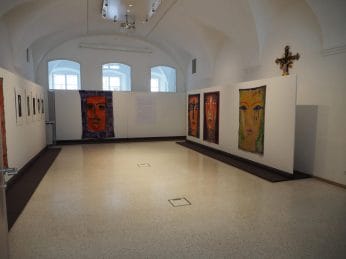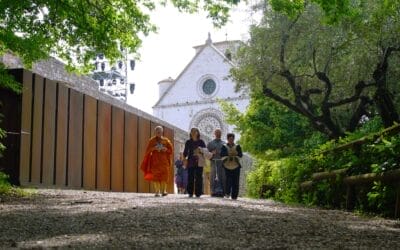Since 2012, theworld-famous Salzburg Festival, the most important event dedicated to classical music, starts with an overture spirituelle:anumberof sacred music concerts and performances dedicated to dialoguebetween religions. Many famous international artists take part in this festival, andthis year, for the first time, the Archdiocese of Salzburg participated with an exhibition of works by the French artist Michel Pochet.  On July 20, 2019 the entrance hall of the Archbishop’s Palace in the city of Salzburg was packed with people.At five o’clock on that Saturday afternoon, Helga Rabl-Stadler, the president of the Festival and Archbishop Franz Lackner inaugurated the exhibition entitled “Lacrimae”(tears), worksof the French artist Michel Pochet. Mgr. Matthäus Appesbacher, the Bishop’s vicar said: “It is the first time that the Salzburg Catholic Church is participating in the so-called ouverture spirituelle of the music festival”. He recountedall about the genesis of this exhibition, andsharedthat when he came to know that Pochet presented his work of art, the weeping face of God-Mercy, as a gift to Pope Francis, he decided to invite the artist to this year’s ouverture spirituelle, the central theme of which was “tears”. In his brief speech Michel Pochet insisted that “beauty is a primary need for man”. He emphasized that artists need to be freed from social uselessness complex, and he related the story of a young man in the Amazon region who managed to support hishungry family by playing his flute. The works chosen for this exhibition, which lasted till July 30, stimulated dialogue. The majestic setting for it was the city of Salsburg, where the legacy of this past Church state stands outeverywhere. Here, the encounter between Church and art speaks with a strong celebratory tone, while Pochet’s works are decidedly anti-triumphalistic in matter, form and content.
On July 20, 2019 the entrance hall of the Archbishop’s Palace in the city of Salzburg was packed with people.At five o’clock on that Saturday afternoon, Helga Rabl-Stadler, the president of the Festival and Archbishop Franz Lackner inaugurated the exhibition entitled “Lacrimae”(tears), worksof the French artist Michel Pochet. Mgr. Matthäus Appesbacher, the Bishop’s vicar said: “It is the first time that the Salzburg Catholic Church is participating in the so-called ouverture spirituelle of the music festival”. He recountedall about the genesis of this exhibition, andsharedthat when he came to know that Pochet presented his work of art, the weeping face of God-Mercy, as a gift to Pope Francis, he decided to invite the artist to this year’s ouverture spirituelle, the central theme of which was “tears”. In his brief speech Michel Pochet insisted that “beauty is a primary need for man”. He emphasized that artists need to be freed from social uselessness complex, and he related the story of a young man in the Amazon region who managed to support hishungry family by playing his flute. The works chosen for this exhibition, which lasted till July 30, stimulated dialogue. The majestic setting for it was the city of Salsburg, where the legacy of this past Church state stands outeverywhere. Here, the encounter between Church and art speaks with a strong celebratory tone, while Pochet’s works are decidedly anti-triumphalistic in matter, form and content.  His canvases, as the one which “speaks” about God’s presence in Auschwitz, demonstrate this. Pochet uses alightstroke on a white cloth almost reduced to shreds. This piece of art depicts God’s crying face-heart looking at the outrageous horror of a mountain of corpses. One detail surprises and almost irritates: each corpse has an identification card, something thatdid not exist in extermination camps. However, we see itin TV detective films: it is only a bureaucratic procedure that draws dead people in morgues out of anonymity. On canvas it is a timid reminder of God’s memory: He does not forget, although an attempt has been made to erase countless names from the face of the earth. Next to this scene, almost as a contrast, there appears a large face of Mary whose linear features, present an almost virile aspect. This cloth soaked in tender colours is full of poetry: Mary’s tears are like pearls of dew and speak of the dawn of a new creation. This exhibition was set up in the entrance hall and an adjacent room. It included a series of graphics in black and white: a “Via Crucis” with scenes from Christ’s passion and others that show today’s sufferings. It also included a series of meditations on other “faces of God”, that show closeness tohis people through his archangels. One can define this as “sacred art”, although it differs a lotfrom works known by this name. It does not depict scenes from the Holy Scripture or – as in the Baroque and Rococo art- the concepts of theologians, but it depicts the audacity of personal reflection. The focus on the face brings to mind the words of the philosopher Giuseppe M. Zanghì, according to whom “the emerging Sacred” in the twenty-first century is “One without a face”, a “Power without a face”.[1]
His canvases, as the one which “speaks” about God’s presence in Auschwitz, demonstrate this. Pochet uses alightstroke on a white cloth almost reduced to shreds. This piece of art depicts God’s crying face-heart looking at the outrageous horror of a mountain of corpses. One detail surprises and almost irritates: each corpse has an identification card, something thatdid not exist in extermination camps. However, we see itin TV detective films: it is only a bureaucratic procedure that draws dead people in morgues out of anonymity. On canvas it is a timid reminder of God’s memory: He does not forget, although an attempt has been made to erase countless names from the face of the earth. Next to this scene, almost as a contrast, there appears a large face of Mary whose linear features, present an almost virile aspect. This cloth soaked in tender colours is full of poetry: Mary’s tears are like pearls of dew and speak of the dawn of a new creation. This exhibition was set up in the entrance hall and an adjacent room. It included a series of graphics in black and white: a “Via Crucis” with scenes from Christ’s passion and others that show today’s sufferings. It also included a series of meditations on other “faces of God”, that show closeness tohis people through his archangels. One can define this as “sacred art”, although it differs a lotfrom works known by this name. It does not depict scenes from the Holy Scripture or – as in the Baroque and Rococo art- the concepts of theologians, but it depicts the audacity of personal reflection. The focus on the face brings to mind the words of the philosopher Giuseppe M. Zanghì, according to whom “the emerging Sacred” in the twenty-first century is “One without a face”, a “Power without a face”.[1]
Peter Seifert , art historian
[1]Giuseppe Maria Zanghí, Notte della cultura europea, Rome 2007, pp. 46-47




0 Comments